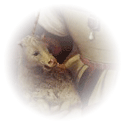 The unicorn according to the Greek myth, was a small animal, similar is size to a kid,
but surprisingly fierce and swift, with a very sharp, single horn in the center
of its forehead. The Latin writers described it as a bull that looks like a deer or a horse with elephant's feet. At the end of the Middle Ages it was most often represented with the body of a horse, a leonine tail, the beard and hooves of a goat, and a large spiral horn in its forehead.
Supposedly no hunter could capture the animal by force but it
could be taken by means of a trick. The hunter was required to lead a young, beautiful virgin to the spot in the forest
frequently visited by the unicorn and to leave her alone there.
Attracted by her innocence, sensing the purity of
the maiden, the unicorn would run to her, lay its head in her lap and fall asleep. Thus its
capture would be effected.
The legend also says that its horn has magical powers: it is able to purify water and recognise poisoned foods.
For this reason, some nobles at the end of the Middle Ages kept goblets or fragments of narwhal tooth ivory as "testers",
as protection against being poisoned.
The unicorn according to the Greek myth, was a small animal, similar is size to a kid,
but surprisingly fierce and swift, with a very sharp, single horn in the center
of its forehead. The Latin writers described it as a bull that looks like a deer or a horse with elephant's feet. At the end of the Middle Ages it was most often represented with the body of a horse, a leonine tail, the beard and hooves of a goat, and a large spiral horn in its forehead.
Supposedly no hunter could capture the animal by force but it
could be taken by means of a trick. The hunter was required to lead a young, beautiful virgin to the spot in the forest
frequently visited by the unicorn and to leave her alone there.
Attracted by her innocence, sensing the purity of
the maiden, the unicorn would run to her, lay its head in her lap and fall asleep. Thus its
capture would be effected.
The legend also says that its horn has magical powers: it is able to purify water and recognise poisoned foods.
For this reason, some nobles at the end of the Middle Ages kept goblets or fragments of narwhal tooth ivory as "testers",
as protection against being poisoned.
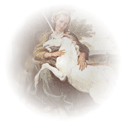 This curious, mysterious animal became the object of allegorized interpretation in the Christian Church.
The unicorn was early accepted as a
symbol of purity in general and of feminine chastity in particular. The legend
was interpreted by Christian writers as an allegory of the Annunciation
and the Incarnation of Christ, born of a Virgin. Thus, the unicorn is usually an
attribute of the Virgin Mary but also of St. Justina of Padua and of St. Justina of
Antioch, who retained their purity under great temptation.
This curious, mysterious animal became the object of allegorized interpretation in the Christian Church.
The unicorn was early accepted as a
symbol of purity in general and of feminine chastity in particular. The legend
was interpreted by Christian writers as an allegory of the Annunciation
and the Incarnation of Christ, born of a Virgin. Thus, the unicorn is usually an
attribute of the Virgin Mary but also of St. Justina of Padua and of St. Justina of
Antioch, who retained their purity under great temptation.
The most fabulous representation of unicorn in the history of art is depicted on the "Lady and the Unicorn" tapestries. Unfortunately, little is known about them. They were woven between 1484- 1500, probably in Flanders (Brussels) for Jean Le Viste, a powerful personage close to King Charles VII of France. In 1841, they were rediscovered in very poor condition by Prosper Mérimée in Boussac castle. In 1842 they were purchased by Edmond Du Sommerard, well known collector of Middle Ages and the Renaissance objects. His collection quickly became famous in Paris and the tapestries became the subject of studies which identified their origin, iconography, and style and became the legend thanks to the works of writer George Sand. In 1882 purchased and restored by the French government for the Musee de Cluny in Paris (now the Musee National du Moyen-Age) where they still hang today.
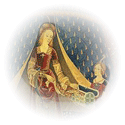 "The Lady with the Unicorn" tapestries completed with 6 pieces, quickly gained a reputation because of the elegance and harmony
of the range of colours where the poetic enchantment was obtained by using a limited number of shades . The marvellous decoration brings
out the elegance of the young lady, dressed with splendour of the precious jewels and her own beauty. She appears in different costumes and attitudes
on each of them.
Each tapestry is usually referred to the sense it depicts: Teste, Touch, Smell, Sound and Sight.
The sixth tapestry introduced or concludes the series, is known as "To My One Desire"
"The Lady with the Unicorn" tapestries completed with 6 pieces, quickly gained a reputation because of the elegance and harmony
of the range of colours where the poetic enchantment was obtained by using a limited number of shades . The marvellous decoration brings
out the elegance of the young lady, dressed with splendour of the precious jewels and her own beauty. She appears in different costumes and attitudes
on each of them.
Each tapestry is usually referred to the sense it depicts: Teste, Touch, Smell, Sound and Sight.
The sixth tapestry introduced or concludes the series, is known as "To My One Desire"
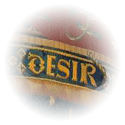 "To My Only Desire" the Lady appears before a tent with the inscription "To my only desire" and seems to
be placing her necklace into a case held out by her servant. Is it the first or the last in the series on the five senses?
Fabulous animals, the lion and the unicorn, wear armour which identifies the sponsor as Jean Le Viste,
a powerful personage close to King Charles VII. Familiar animals, a rabbit, birds, a monkey, inhabit the background
of the tapestries and create a dream-like universe.
"To My Only Desire" the Lady appears before a tent with the inscription "To my only desire" and seems to
be placing her necklace into a case held out by her servant. Is it the first or the last in the series on the five senses?
Fabulous animals, the lion and the unicorn, wear armour which identifies the sponsor as Jean Le Viste,
a powerful personage close to King Charles VII. Familiar animals, a rabbit, birds, a monkey, inhabit the background
of the tapestries and create a dream-like universe.
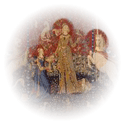 "Taste" : the lion and the unicorn frame the Lady who, eyes turned towards a parrot in her right hand, is
taking a sweet from the candy dish offered to her by her servant. Her little dog follows her every move,
whilst at her feet a leering monkey, eating a berry or a candy, highlights the significance of the scene.
"Taste" : the lion and the unicorn frame the Lady who, eyes turned towards a parrot in her right hand, is
taking a sweet from the candy dish offered to her by her servant. Her little dog follows her every move,
whilst at her feet a leering monkey, eating a berry or a candy, highlights the significance of the scene.
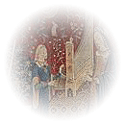 "Hearing": the Lady plays a portable (or positive) organ placed on a table covered with an oriental (
probably Turkish) rug.
The lion and the unicorn frame the scene and appear as decorative patterns on the
organ's side facings.
"Hearing": the Lady plays a portable (or positive) organ placed on a table covered with an oriental (
probably Turkish) rug.
The lion and the unicorn frame the scene and appear as decorative patterns on the
organ's side facings.
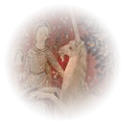 "Sight": in a familiar manner, the unicorn has placed its front paws on the Lady's knees and looks at its reflection in a mirror she holds.
"Sight": in a familiar manner, the unicorn has placed its front paws on the Lady's knees and looks at its reflection in a mirror she holds.
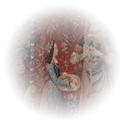 "Smell": the Lady is making a flower chain. Behind her, the monkey once again provides the key to this allegory: he is inhaling the perfume of a rose he stole from her basket.
"Smell": the Lady is making a flower chain. Behind her, the monkey once again provides the key to this allegory: he is inhaling the perfume of a rose he stole from her basket.
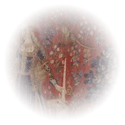 "Touch": tapestry is devoted to the glorification of the Le Viste family.
The Lady, superbly attired, holds a flag with the coat of arms of the Le Viste family in one hand
and pets the
unicorn with the other. Both lion and unicorn bear their coat of arms also.
"Touch": tapestry is devoted to the glorification of the Le Viste family.
The Lady, superbly attired, holds a flag with the coat of arms of the Le Viste family in one hand
and pets the
unicorn with the other. Both lion and unicorn bear their coat of arms also.